语法with+复合宾语”结构
语法之with+复合宾语
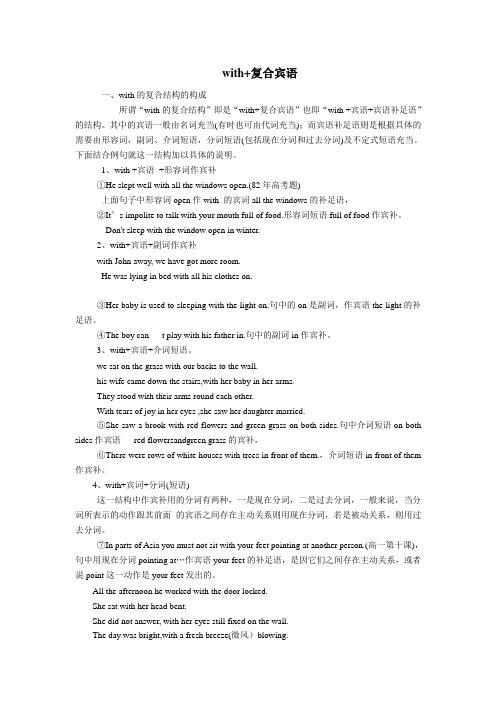
with+复合宾语一、with的复合结构的构成所谓“with的复合结构”即是“with+复合宾语”也即“with +宾语+宾语补足语”的结构。
其中的宾语一般由名词充当(有时也可由代词充当);而宾语补足语则是根据具体的需要由形容词,副词、介词短语,分词短语(包括现在分词和过去分词)及不定式短语充当。
下面结合例句就这一结构加以具体的说明。
1、with +宾语+形容词作宾补①He slept well with all the windows open.(82年高考题)上面句子中形容词open作with 的宾词all the windows的补足语,②It’s impolite to talk with your mouth full of food.形容词短语full of food作宾补。
Don't sleep with the window open in winter.2、with+宾语+副词作宾补with John away, we have got more room.He was lying in bed with all his clothes on.③Her baby is used to sleeping with the light on.句中的on是副词,作宾语the light的补足语。
④The boy can t play with his father in.句中的副词in作宾补。
3、with+宾语+介词短语。
we sat on the grass with our backs to the wall.his wife came down the stairs,with her baby in her arms.They stood with their arms round each other.With tears of joy in her eyes ,she saw her daughter married.⑤She saw a brook with red flowers and green grass on both sides.句中介词短语on both sides作宾语red flowersandgreen grass的宾补,⑥There were rows of white houses with trees in front of them.,介词短语in front of them 作宾补。
with复合结构

4.with+名词(或代词)+介词短语
With the children at school, we can't
take our vacation when we want to. 由于孩子们在上学,所以当我们想度假时而不能去度 假。(原因状语)
5.with+名词(或代词)+副词 He fell asleep with the light on. 他睡着了,灯还亮着。(伴随情况) The boy stood there with his head down. 这个男孩低头站在那儿。(伴随情况)
3.with+名词(或代词)+形容词
e.g. I like to sleep with the windows open. 我喜欢把窗户开着睡觉。(伴随情况)
With the weather so close and stuffy通风不良的, ten to one it’ll rain presently. 天气这样闷,十之八九要下雨。(原因状语)
with复合结构
with结构也称为with复合结构。是由with+复合宾语组成。 常在句中做状语,表示谓语动作发生的伴随情况、时间、 原因、方式等。其构成有下列几种情形:
1.with+名词(或代词)+现在分词 此时,现在分词和前面的名词或代词是逻辑上的主谓关系。
With prices going up so fast, we can’t afford luxuries. 由于物价上涨很快,我们买不起高档商品。(原因状语) With the crowds cheering, they drove to the palace. 在人群的欢呼声中,他们驱车来到皇宫。(伴随情况)
“with + 复合宾语”结构归纳

“with+ 复合宾语”结构归纳“with+复合宾语”是高中教学的难点,也是高考的考点,在句中可作时间状语、条件状语、方式状语、原因状语、伴随情况等。
为了帮助同学们掌握其特点,将其用法归纳如下:1.with+名词+形容词:如:Before he came here, my father used to sleep with his eyes open.我父亲来这儿之前,常常睁着眼睛睡觉。
(注意:with不能用while来替换。
)(表示伴随情况)2.with+名词+副词:常用的副词是:in, on, over, out等。
如:He was standing there with nothing on.他一丝不挂地站在那里。
(表示伴随情况。
)We went home with our work over.我们工作做完就回家了。
(表示时间。
)3.with+名词+介词短语:如:The teacher came into the classroom with a book in his hand.= The teacher came into the classroom, book in hand.老师手里拿着本书走进了教室。
(表示伴随情况。
)The soldier had him stand with his back to his father.士兵让他背向着父亲站着。
(表示行为方式。
)4.with+名词+过去分词:如:He stood for an instant with his hand still raised.他站了一刹那,他的手仍然举着。
(raised与with的宾语hand有逻辑上的动宾关系。
)I will have to buy a new one with my glasses broken.(broken与with 的宾语glasses有逻辑上的动宾关系。
)5.with+名词+现在分词:如:The English class ended with all singing an English song.英语课以全体合唱一首英语歌而结束。
高中英语教学热点易混点详解之With的复合结构

高中英语教学热点易混点详解之With的复合结构英语中的with复合结构也叫“with+复合宾语”结构,即with+宾语+宾语补足语。
其用法归纳如下:“with+复合宾语结构”按其构成可分为:1、with+宾语+介词短语1).English lessons are broadcast every day on the radio with explanations in English and other languages.广播电台每天播放英语课程,并用英语或其他语言进行解说。
2).BBCEnglish broadcasts programmes for China with explanations in Chinese.BBC英语对中国广播的节目是用汉语进行解释的。
2、with+宾语+现在分词1).The Yangtze River is very busy with so many boats and ships coming and going every day.每天长江上各种船只来来往往显得格外忙碌。
2).The young woman,with a baby sleeping in her arms,was wandering in the street.那位年轻妇女,怀抱一个熟睡的婴儿,漫步在大街上。
3、with+宾语+过去分词1).The boy was crying with the toy broken.玩具破了,那男孩在哭。
2).You should go to sleep with the light turned off.你应该把灯熄了再睡。
4、with+宾语+动词不定式1).With so many essays to write,he won’t have time to go shopping this morning.他有那么多文章要写,今天没有时间去买东西。
With 复合结构【精】【骆驼整理】

With 复合结构【精】With 复合结构“With复合结构”即:“with +宾语+补足语”With复合结构在英语中,尤其是在书面语中是一种很常用的结构,它既可以充当状语,又可以充当定语。
由于“with 复合结构”在逻辑上是一个主谓关系完整的结构,因而,它也可以用相应的从句和分句来代替。
一、with复合结构的构成它是由介词with或without+复合结构构成,复合结构作介词with或without的复合宾语,复合宾语中第一部分宾语由名词或代词充当,第二部分补足语由形容词、副词、介词短语、动词不定式或分词充当,分词可以是现在分词,也可以是过去分词。
形容词副词表示状态介词短语With+宾语+ 名词V-ing 主谓、进行V-ed 动宾、完成to do 主谓、将要发生标志:作状语用逗号隔开,with结构放句子前后皆可;做方式、伴随状语和定语时,不用逗号隔开,放在句子后面。
1、with+宾语+副词The square looks more beautiful with all the lights on.所有的灯都亮时,广场看起来更美丽。
With his parents away,Tom becomes more naughty.父母不在,汤姆变得更加淘气。
The girl fell asleep, with the light on.女孩睡着了,灯还亮着。
With the meal over , we all went home.(做时间状语)吃完饭,我们都回家了。
Two men with life jackets on are floating along the river.两个身穿救生衣的男人正沿着河流漂浮着。
He fell asleep,with the radio on.他睡着了,录音机还开着。
2、with+宾语+形容词With the weather so close and stuffy, ten to one it’ll rain presently. 天气这么闷热,十之八九要下雨。
英语 语法 with的复合结构

二、with结构的特点
• 1、with结构由介词with或without+复合结构构成。复合结构中第 一部分与第二部分语法上是宾语和宾语补足语关系,而在逻辑上, 却具有主谓关系,也就是说,可以用第一部分作主语,第二部分 作谓语,构成一个句子。 1)With him taken care of,we felt quite relieved.(He was taken good care of.) 2) She fell asleep with the light burning.(The light was burning.)
英语
Unit 2
模块1
home alone
with的复合结构
With复合结构,是由with+宾语+宾补组成,在句中常做状语, 如伴随、时间、原因、方式状语等
一、with结构的构成 它是由介词with或without+复合结构构成,复合结构作 介词with或without的复合宾语,复合宾语中第一部分宾语由 名词或代词充当,第二部分补足语由形容词、副词、介词短 语、动词不定式或分词充当,分词可以是现在分词,也可以 是过去分词。
• 3、with结构作状语时,不定式、现在分词、过去分词的 区别:在with结构中,不定式、现在分词作宾补,表示 主动,但是不定式表示将要发生的动作,而现在分词表 示正在发生或发生了的动作;过去分词表示被动或完成。
With the boy leading the way,we found the house easily.
• 2、with+名词+介词短语 Do you know the woman with a baby in her arms. (who has a baby in her arms) With the children at school,we can’t take our vacation when we want to.
With的复合宾语结构及分词的独立主格结构
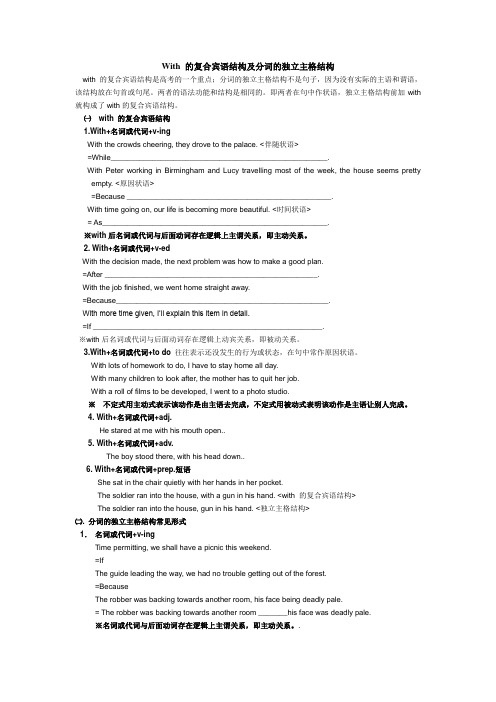
With 的复合宾语结构及分词的独立主格结构with 的复合宾语结构是高考的一个重点;分词的独立主格结构不是句子,因为没有实际的主语和谓语,该结构放在句首或句尾。
两者的语法功能和结构是相同的。
即两者在句中作状语,独立主格结构前加with 就构成了with的复合宾语结构。
㈠with 的复合宾语结构1.With+名词或代词+v-ingWith the crowds cheering, they drove to the palace. <伴随状语>=While____________________________________________________.With Peter working in Birmingham and Lucy travelling most of the week, the house seems pretty empty. <原因状语>=Because _________________________________________________.With time going on, our life is becoming more beautiful. <时间状语>= As______________________________________________________.※with后名词或代词与后面动词存在逻辑上主谓关系,即主动关系。
2. With+名词或代词+v-edWith the decision made, the next problem was how to make a good plan.=After ___________________________________________________.With the job finished, we went home straight away.=Because___________________________________________________.With more time given, I’ll explain this item in detail.=If _______________________________________________________.※with后名词或代词与后面动词存在逻辑上动宾关系,即被动关系。
语法with+复合宾语”结构

With + 复合宾语结构请看NMET2000高考题:_____ the production up by 60%,the company has had another excellent year.A.As B.For C.With D.Through这道题的正确答案是C。
句中的“With+宾语+宾语补足语”结构作状语,表原因。
全句的意思是:由于生产增长了60%,这家公司又迎来了一个丰收年。
“with +复合宾语”结构中的宾语补足语通常由介词短语、现在分词、过去分词、不定式、形容词、副词或名词充当。
它在中学英语课本中多次出现,现将其构成与句法作用归纳如下:“with +复合宾语”结构的一般构成:with +宾语+介词短语English lessons are broadcast every day on the radio with explanations inEnglish and other languages.with +宾语+现在分词In parts of Asia you must not sit with your feet pointing at another person.with +宾语+过去分词He stood for an instant with his hand raised.他举着手站了一会儿。
with +宾语+不定式With so much homework to do,I can't go to the party tonight.由于有这么多家庭作业要做,今天晚上我不能去参加晚会。
with +宾语+形容词He usually sleeps with the windows open even in winter.即使在冬天,他也常常开着窗户睡觉。
with +宾语+副词One family lived in a house with very tall trees all round.with +宾语+名词In the centre of London there is a tall white building with the name“Bush House”.“with +复合宾语”结构的句法作用:作时间状语With my homework finished(=After I finished my homework),I went fishing with my father.做完家庭作业后,我和爸爸去钓鱼了。
with的复合宾语

with 复合宾语With是个介词,基本的意思是“用”,“with+复合宾语”主要用来说明附带情况或具体细节,在句中主要用作状语,有时也用作补足语“with+复合宾语”结构与“without+复合宾语”结构用法相同,只不过用without时表示否定意义例如:. With a taxi coming soon, I’ll be able to get there on time.出租车一会儿来,我可以准时到达那里。
Without a taxi coming soon, I’ll be late for the meeting.如果没有出租车来,我去开会就要迟到。
With 复合结构指的是“with+宾语+宾语补足语”结构.可以总结为以下7种形式:形式一with+宾语+形容词He often sleeps with the windows open. 他常开着窗睡觉。
Don’t speak with your mouth full. 不要满嘴巴食物说话。
形式二with+宾语+副词He stood before his teacher with his head down. 他低着头站在老师面前。
He was lying on the bed with all his clothes on. 他和衣躺在床上。
形式三with+宾语+名词He died with his daughter yet a schoolgirl. 他去世时,女儿还是个小学生。
形式四with+宾语+介词短语She said good-bye with tears in her eyes. 她含着眼泪说了声再见。
He was asleep with his head on his arms. 他头枕着胳膊睡着了。
形式五with+宾语+现在分词(短语)He fell asleep with the lamp burning. 他没熄灯就睡着了。
with结构也称为with复合结构

with结构也称为with复合结构,是由with+复合宾语组成,常在句中做状语,表示谓语动作发生的伴随情况、时间、原因、方式等.其构成有下列几种情形:1、with + 名词 (或代词) + 现在分词此时,现在分词和前面的名词或代词是逻辑上的主谓关系.例如:______ prices ________up so fast,we can't afford luxuries.由于物价上涨很快,我们买不起高档商品.(原因状语)________ the crowds _____________,they drove to the palace.在人群的欢呼声中,他们驱车来到皇宫.(伴随情况)2、with + 名词 (或代词) + 过去分词此时,过去分词和前面的名词或代词是逻辑上的动宾关系.例如:I sat in my room for a few minutes ________ my eyes _______ on the ceiling.我在房间坐了一会儿,眼睛盯着天花板.(伴随情况)She had to walk home ________________________.自行车被偷,她只好步行回家.(原因状语)3、with + 名词 (或代词) + 形容词I like to sleep ____________________________________我喜欢把窗户开着睡觉.(伴随情况)4、with + 名词 (或代词) + 介词短语______________________________________,we can't take our vacation when we want to.由于孩子们在上学,所以当我们想度假时而不能去度假.(原因状语)5、with + 名词 (或代词) + 副词He fell asleep__________________________他睡着了,灯还亮着.(伴随情况)The boy stood there ______________________________这个男孩低头站在那儿.(伴随情况)6 、with + 名词 (或代词) + 动词不定式此时,不定式表示将发生的动作.例如:___________________________________________,John felt miserable.由于没人可以说话的人,约翰感到很悲哀.(原因状语)__________________________________________________________,he wasn't allowed to go out.因为还有很多工作要做,他没有被允许外出.(原因状语)Leave1. leave some place (离开某地), leave for some place (离开到某地), leave school (退学).:2. leave (遗留;遗忘).通常用于如下结构中: leave sth / sb at home (把某物遗忘在家;把某人留在家), leave sth / sb behind (留下;遗落).如:___________________________________________我又一次把英语书遗落在家里.___________________________________那小孩被留在家里.3. leave (听任其在某处;使保持某状态).通常用于一些复合结构中,如:“ leave+ 宾语+形容词 / 分词 / 不定式等”以及短语leave … alone (不理会;不管).如:The teacher left little Tom ___________________all the time. 老师让小汤姆一直站着. Leave him ____ ______ it himself. 让他自个儿去做这件事吧.4. leave (留下;剩下).如:His only relative died, _________him nothing. 他惟一的亲人死了,什么也没给他留下.注意:分词left 作定语时,要放在所修饰的词后面,如果要用前置定语,则可以使用remaining .如:Don't hurry, there are ten minutes____________不要着急,还有十分钟.5. leave (留住;留言).常用于以下短语: leave word (留信息), leave a message (留言;留口信).如:Sorry, John isn't in, please leave a message.6. leave (准假;休假;假期).常用于以下结构: ask for ( a ) leave (请假)。
“with+复合宾语”结构与独立主格结构

“with+复合宾语”结构与独立主格结构崔长平河南遂平一高(463100)“with+复合宾语”结构和独立主格结构是涉及到非谓语动词用法的两个主要结构,也是学生不易掌握的两个用法。
现将其基本构成及一般用法分陈如下:Ⅰ.“with+复合宾语结构”通常有以下五种构成形式:①with+宾语+动词不定式(或动词不定式短语)(本结构中的动词不定式视具体情况可以是一般式、完成式或被动式。
)e.g. With her to help me,I feel quite at ease.He was left alone with no one to look after him.With him to give us a lead,our team is bound to turn out well.②with+宾语+现在分词(或现在分词短语)(本结构中若使用现在分词的主动形式,说明宾语和宾补之间存在着逻辑上主动的主谓关系;若现在分词使用了被动形式,则说明宾语和宾补之间存在着逻辑上被动的主谓关系。
)e.g. I saw her driving along,with her hair streaming in the wind.Peter soon fell asleep with the light still burning.I won′t be able to go on holiday with my mother being ill.From space the earth looks like a huge water-covered glob,with a few patches of land sticking out above the water.With the boy leading the way,we found his house with no difficulty.③with+宾语+过去分词(或过去分词短语)(在本结构中,宾语和宾补之间存在着逻辑上被动的主谓关系,)e.g. All the afternoon he worked with the door locked.She sat there with her head bent.The thief was brought in with his hands tied behind his back.④with+宾语+介词短语e.g. The peasants walked to the fields with hoes and spades on their shoulders.Mr. Smith came into the classroom with a ruler under his arm and a thick book in his hand.He looked at his son,one hundred paces away with an apple on his head.Bamboo grows up straight and thin,with branches at the top.She left the office with tears in her eyes.⑤with +宾语+形容词(短语)或副词(短语)e.g. It is rude to speak with your mouth full.He used to sleep with the windows open.With John away,we have got more room.The streets looked more beautiful with all the lights on.“with+复合宾语结构”的否定形式是“without+复合宾语结构”。
外研版高中英语语法必修一with的复合结构
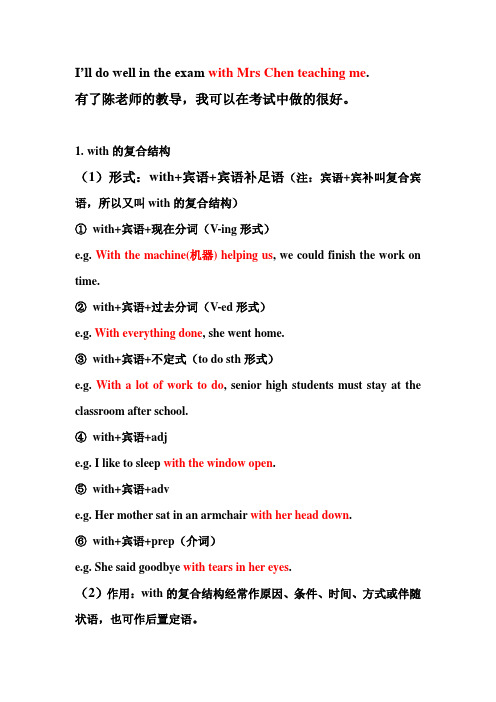
I’ll do well in the exam with Mrs Chen teaching me.有了陈老师的教导,我可以在考试中做的很好。
1.with的复合结构(1)形式:with+宾语+宾语补足语(注:宾语+宾补叫复合宾语,所以又叫with的复合结构)①with+宾语+现在分词(V-ing形式)e.g. With the machine(机器) helping us, we could finish the work on time.②with+宾语+过去分词(V-ed形式)e.g. With everything done, she went home.③with+宾语+不定式(to do sth形式)e.g. With a lot of work to do, senior high students must stay at the classroom after school.④with+宾语+adje.g. I like to sleep with the window open.⑤with+宾语+adve.g. Her mother sat in an armchair with her head down.⑥with+宾语+prep(介词)e.g. She said goodbye with tears in her eyes.(2)作用:with的复合结构经常作原因、条件、时间、方式或伴随状语,也可作后置定语。
导学案P241.TFFFT2.CACB3.making/clearly/with/coming/on/of/organised/enjoys/excited/bored导学案P301.being punished/ repeating/ To avoid2.immediately/ immediately3.it/ saving/ being treated/ appreciation4.admitting/ cheating(having cheated)/ to be/ admission5.of/ in/ from/ resulted from6.She told us about some amusing things in her holiday.The monitor planned to organise an outdoor activity.They were always very strict with their children.You had better make sure how much the sofa is.Don’t be afraid to admit your mistakes.They built a wall to avoid soil being washed away.。
with的复合宾语
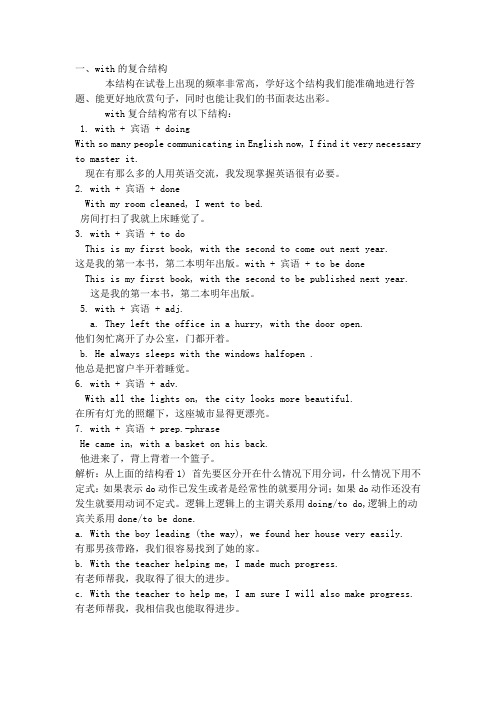
一、with的复合结构本结构在试卷上出现的频率非常高,学好这个结构我们能准确地进行答题、能更好地欣赏句子,同时也能让我们的书面表达出彩。
with复合结构常有以下结构:1. with + 宾语 + doingWith so many people communicating in English now, I find it very necessary to master it.现在有那么多的人用英语交流,我发现掌握英语很有必要。
2. with + 宾语 + doneWith my room cleaned, I went to bed.房间打扫了我就上床睡觉了。
3. with + 宾语 + to doThis is my first book, with the second to come out next year.这是我的第一本书,第二本明年出版。
with + 宾语 + to be doneThis is my first book, with the second to be published next year.这是我的第一本书,第二本明年出版。
5. with + 宾语 + adj.a. They left the office in a hurry, with the door open.他们匆忙离开了办公室,门都开着。
b. He always sleeps with the windows halfopen .他总是把窗户半开着睡觉。
6. with + 宾语 + adv.With all the lights on, the city looks more beautiful.在所有灯光的照耀下,这座城市显得更漂亮。
7. with + 宾语 + prep.-phraseHe came in, with a basket on his back.他进来了,背上背着一个篮子。
解析:从上面的结构看1) 首先要区分开在什么情况下用分词,什么情况下用不定式:如果表示do动作已发生或者是经常性的就要用分词;如果do动作还没有发生就要用动词不定式。
with复合结构用法归纳

with 复合结构用法归纳with的复合结构是高中阶段英语语法的一个难点,也是高考英语试题的一个考察热点。
下面就其用法进行归纳,以期对高中学生的英语学习有所帮助。
with的复合结构是一种较为特殊的书面表达形式。
它是一个介词短语,而不是一个句子。
with后的宾语相当于该结构的主语,而宾语补足语相当于该结构的逻辑谓语。
由于这种结构形式多样,作用复杂,较难把握。
因此在学习中一定要注意区分,仔细领悟。
一、with复合结构的构成:with+宾语(名词/代词)+介词短语/形容词/副词/现在分词/过去分词/动词不定式/名词。
1.w ith+宾语+介词短语(介词短语表示宾语所处的状态)(1)She left the office with tears in her eyes.(2)The teacher came in with a book in his hand.2.with+宾语+形容词(形容词表示宾语的特性和状态)(1)He used to sleep with the window open.(2)When he is eating, he doesn’t speak with his month full of food.3.with+宾语+副词(副词表示宾语所处的状态)(1)With John away, we’ve got more room.(2)Our city looks more beautiful than ever with all the lights on.4.with+宾语+现在分词(现在分词表示宾语正在进行的动作或主动的动作)(1)He lay there with his eyes looking at the sky.(2)She fell asleep with the light burning.5.with+宾语+过去分词(过去分词和宾语构成动宾关系,且宾语是动作的承受者)(1)The thief was brought in with his hands tied back.(2)All the afternoon he worked with the door locked.6. with+宾语+动词不定式(动词不定式表示主动或将来的动作)(1)I can’t go out with all these dishes to wash.(2)With all these mouths to feed, he did’t know what to do.7.with+宾语+名词(名词表示宾语是什么)(1)He dug a deep hole with a spade his tool.(2)Lu Xun fought against the enemy with a pen his only weapon.二、with复合结构的用法:with复合结构主要用了来说明附带情况或具体细节,在句中用作状语,表示条件、原因、时间、方式或伴随情况等,可以和相应的状语从句转换。
with 的复合结构和独立主格
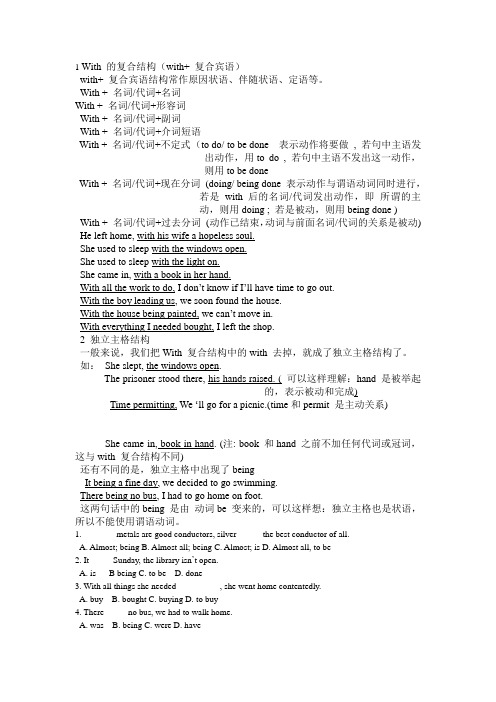
1 With 的复合结构(with+ 复合宾语)with+ 复合宾语结构常作原因状语、伴随状语、定语等。
With + 名词/代词+名词With + 名词/代词+形容词With + 名词/代词+副词With + 名词/代词+介词短语With + 名词/代词+不定式(to do/ to be done 表示动作将要做, 若句中主语发出动作,用to do , 若句中主语不发出这一动作,则用to be doneWith + 名词/代词+现在分词(doing/ being done 表示动作与谓语动词同时进行,若是with 后的名词/代词发出动作,即所谓的主动,则用doing ; 若是被动,则用being done )With + 名词/代词+过去分词(动作已结束,动词与前面名词/代词的关系是被动) He left home, with his wife a hopeless soul.She used to sleep with the windows open.She used to sleep with the light on.She came in, with a book in her hand.With all the work to do, I don’t know if I’ll have time to go out.With the boy leading us, we soon found the house.With the house being painted, we can’t move in.With everything I needed bought, I left the shop.2 独立主格结构一般来说,我们把With 复合结构中的with 去掉,就成了独立主格结构了。
如:She slept, the windows open.The prisoner stood there, his hands raised. ( 可以这样理解:hand 是被举起的,表示被动和完成)Time permitting, We ‘ll go for a picnic.(time和permit 是主动关系)She came in, book in hand. (注: book 和hand 之前不加任何代词或冠词,这与with 复合结构不同)还有不同的是,独立主格中出现了beingIt being a fine day, we decided to go swimming.There being no bus, I had to go home on foot.这两句话中的being 是由动词be 变来的,可以这样想:独立主格也是状语,所以不能使用谓语动词。
with的七种复合结构用法
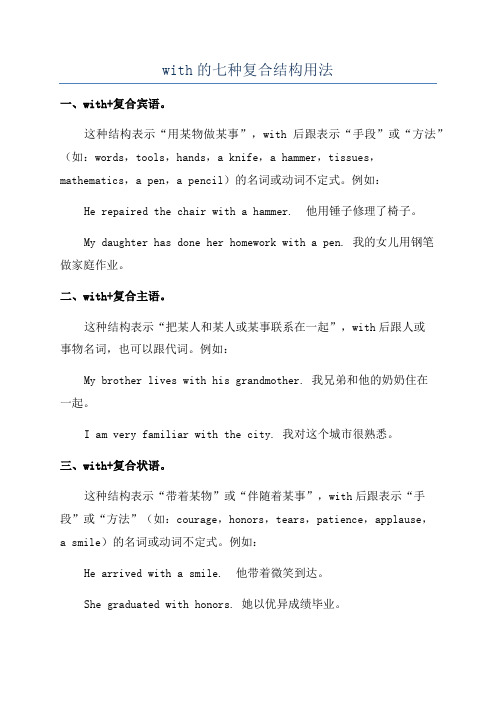
with的七种复合结构用法一、with+复合宾语。
这种结构表示“用某物做某事”,with后跟表示“手段”或“方法” (如:words,tools,hands,a knife,a hammer,tissues,mathematics,a pen,a pencil)的名词或动词不定式。
例如:He repaired the chair with a hammer. 他用锤子修理了椅子。
My daughter has done her homework with a pen. 我的女儿用钢笔做家庭作业。
二、with+复合主语。
这种结构表示“把某人和某人或某事联系在一起”,with后跟人或事物名词,也可以跟代词。
例如:My brother lives with his grandmother. 我兄弟和他的奶奶住在一起。
I am very familiar with the city. 我对这个城市很熟悉。
三、with+复合状语。
这种结构表示“带着某物”或“伴随着某事”,with后跟表示“手段”或“方法”(如:courage,honors,tears,patience,applause,a smile)的名词或动词不定式。
例如:He arrived with a smile. 他带着微笑到达。
She graduated with honors. 她以优异成绩毕业。
四、with+复合表语。
这种结构表示“和……一起”,with后跟名词、代词、形容词或动词不定式。
例如:The house is furnished with modern furniture. 这个房子里有现代家具。
The room is filled with sunshine. 这个房间里充满阳光。
五、with+复合宾语从句。
这种结构表示“做某事时考虑某事”,with后有从句,这个从句有时是否定的。
例如:He dealt with the problem with much patience. 他耐心地处理这个问题。
with+复合宾语”结构既可用作定语,也可用作状语

2.“with+复合宾语”结构既可用作定语,也可用作状语。
常见的“with+复合宾语”结构主要有以下五种形式:1)with+宾语+动词-ing形式①With the boy leading the way, we have no trouble in getting to the station.由这个男孩带路,我们很容易到了火车站。
②With the wind blowing heavily, we took great trouble to move on to the front.由于风刮得很大,我们费力的往前线进发。
2)with+宾语+过去分词(past participle)①The child was crying with the glasses broken.眼镜破了,那小孩哭了起来.②With all the work finished, they hurried back home for lunch.所有的工作都做完了,他们匆忙回家吃午饭。
3)with+宾语+不定式①With a lot of work to do, we had to be busy working day and night.有这么多的工作要做,我们只得日夜忙碌。
②With many things to deal with, I have to stop listening to the light music.有许多事要处理,我只好停止听轻音乐。
4)with+宾语+介词短语①The teacher entered the classroom with a book in his hand.老师手中拿着一本书走进教室。
②She saw a small river with green grass and red flowers on both sides.她看到一条小河,两岸长满了红花绿草。
5) with+宾语+形容词(或副词)①Don't sleep with the door and windows open.不要开着门窗睡觉。
with的复合结构
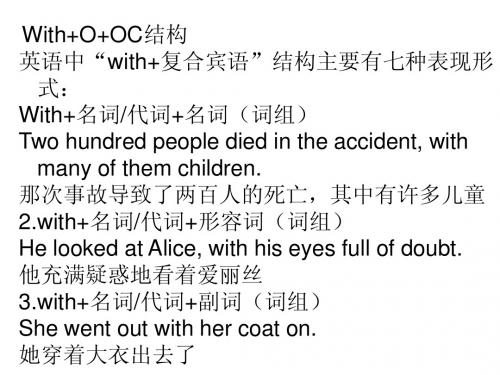
With+O+OC结构 英语中“with+复合宾语”结构主要有七种表现形 式: With+名词/代词+名词(词组) Two hundred people died in the accident, with many of them children. 那次事故导致了两百人的死亡,其中有许多儿童 2.with+名词/代词+形容词(词组) He looked at Alice, with his eyes full of doubt. 他充满疑惑地看着爱丽丝 3.with+名词/代词+副词(词组) She went out with her coat on. 她穿着大衣出去了
4. with+名词/代词+介词(词组) We used to work in a town with rivers around it. 我们以前住在一个四面环水的城镇里 5.with+名词/代词+--ing分词(词组) With so many people helping me, I succeeded at last. 最终,我在许多人的帮助下取得了成功 6.with + 名词/代词+ --ed分词(词组) With the job finished, we went to China for a holiday. 那项工作做完以后,我们就去中国度假了
7.with+名词/代词+不定式(词组) With these people to help her, she tried to write a paper. 有这些人的帮忙,她试着写一篇论文 注:这种复合结构多做状语,其中充当宾补的 现在分词表示动作正在进行,过去分词表示被 动动作,不定式表示将来的动作,介词、副词、 形容词表示一种状态
- 1、下载文档前请自行甄别文档内容的完整性,平台不提供额外的编辑、内容补充、找答案等附加服务。
- 2、"仅部分预览"的文档,不可在线预览部分如存在完整性等问题,可反馈申请退款(可完整预览的文档不适用该条件!)。
- 3、如文档侵犯您的权益,请联系客服反馈,我们会尽快为您处理(人工客服工作时间:9:00-18:30)。
With + 复合宾语结构
请看NMET2000高考题:_____ the production up by 60%,the company has had another excellent year.A.As B.For C.With D.Through
这道题的正确答案是C。
句中的“With+宾语+宾语补足语”结构作状语,表原因。
全句的意思是:由于生产增长了60%,这家公司又迎来了一个丰收年。
“with +复合宾语”结构中的宾语补足语通常由介词短语、现在分词、过去分词、不定式、形容词、副词或名词充当。
它在中学英语课本中多次出现,现将其构成与句法作用归纳如下:
“with +复合宾语”结构的一般构成:
with +宾语+介词短语English lessons are broadcast every day on the radio with explanations in
English and other languages.
with +宾语+现在分词In parts of Asia you must not sit with your feet pointing at another person.with +宾语+过去分词He stood for an instant with his hand raised.他举着手站了一会儿。
with +宾语+不定式With so much homework to do,I can't go to the party tonight.
由于有这么多家庭作业要做,今天晚上我不能去参加晚会。
with +宾语+形容词He usually sleeps with the windows open even in winter.
即使在冬天,他也常常开着窗户睡觉。
with +宾语+副词One family lived in a house with very tall trees all round.
with +宾语+名词In the centre of London there is a tall white building with the name“Bush House”.
“with +复合宾语”结构的句法作用:
作时间状语
With my homework finished(=After I finished my homework),I went fishing with my father.做完家庭作业后,我和爸爸去钓鱼了。
作条件状语
With everything considered(=If everything is considered),his plan is better than yours.
全面考虑的话,他的计划要比你的好。
作原因状语
With his key missing(=Because his key is missing),he had to stay outside.
由于钥匙丢了,他只得呆在外面。
作伴随状语
The girl stood there silently,with tears in her eyes(=and tears were in her eyes).
那个女孩默默地站在那儿,眼里噙着泪水。
作定语
Do you know the woman with a baby in her arms(=who has a baby in her arms)?你认识那位怀里抱着小孩的妇女吗?
也谈“with+复合宾语”结构
有一道高考英语试题单项选择题为:
_______ two exams to worry about,l have to work really hard this weekend.
A.with
B.Besides
C.As for
D.Because of (A为正确答案)
该题中出现了“with+复合宾语”结构。
这种结构不仅是历年高考的一个考点,也在中学课本中频频出现。
本文拟结合高考题和教材,将“with+复合宾语”结构
和用法作一归纳,供教师备课和学生学习时参考。
一、“with+复合宾语”结构的形式
“with+复合宾语”结构通常有以下六种形式:
1.“with+宾格词+形容词”
In summer we often sleep with the windows open.
With everything ready,we started to work.
2.“with+宾格词+现在分词”
In some parts of Asia it’s not polite to sit with your foot pointing at another person.
With so many people communicating in English every day,it will become more and more important to have a good knowledge of English.
3. “with+宾格词+过去分词”
All the afternoon he worked with the door locked
The murderer was brought in,with his hands _______ behind his back..
A.being tied
B.having tied
C.to be tied
D.tied (D为正确答案)
4. “with+宾格词+介词短语”
The teacher walked into the classroom with a ruler under his arm.
The guard rushed out with a gun in his hand.
5.“with+宾格词+副词”
Our city looks more beautiful with all the lights on.
_____ production up by 60﹪,the company has had another excellent year.
A.As
B.For
C.With
D.Through (C为正确答案)
6. “with+宾格词+不定式”
With a lot of difficult problems_____,the newly--elected president is having a hard time.
(C为正确答案)
With him to stay in the house, l feel quite safe.
二、“with+复合宾语”结构的用法
“with+复合宾语”主要用来说明附带情况或具体细节,在句中主要用作状语,有时也用作定语补足语、宾语补足语或主语补足语。
1.作状语
①伴随/方式状语He lay there thinking,with his head on his hands.
②时间状语With the meeting over,they left the meeting room.
③原因状语With the key lost,she couldn’t enter the house.
④条件状语With Li ping to help us.l’m sure we can finish the job ahead of time.
2.作定语The young woman with a baby in her arms is Tom’s elder sister.
3.作宾语补足语或主语补足语
The next morning the lake was found with a thin sheet of ice on.(.作主语补足语)该句意思同:Somebody found the lake with a thin sheet of ice on..(作宾语补足语)
【注】
1.“with+复合宾语”结构与“without+复合宾语”结构用法相同,只不过用without时表示否定意义。
试比较以下两句话的意义:
With a taxi coming soon,l’ll be ablet to get there on time.出租车一会儿来,我可以准时到达那里。
Without a taxi coming soon,l’ll be late for the meeting. 如果没有出租车来,我去开会就要迟到。
2.“with+复合宾语”结构与独立主格结构联系密切;如果在“with+复合宾语”中将with去掉,便可变成独立主格结构。
例如:With spring coming on, the trees turned green.
=Spring coming on,the trees turned green.
Wih the key lost,she couldn’t enter the house.
=The key lost,she couldn’t enter the house.。
